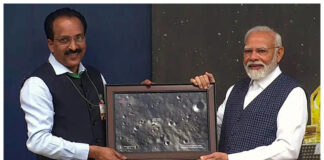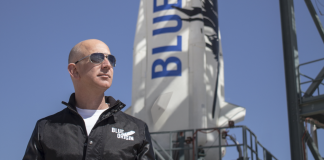SEPTEMBER 6, 2019

Jerry M Linenger, former NASA astronaut and space analyst, is in India for a live show on the journey of Chandrayaan 2 to the moon on National Geographic. Linenger has spent five months aboard the Russian Space Station Mir and has survived the most severe fire on an orbiting spacecraft. During the mission, the former NASA astronaut logged 50 million miles in space, an equivalent of 110 round-trips to the moon.
Q: What does Chandrayaan-2 mission mean for the world?
A: This mission goes beyond the people of India; it advances the knowledge of all of mankind. With Chandrayaan 2, we will find out more about the South Pole of the moon. It adds to the existing knowledge base and will be very helpful for the decades to come for all space-faring countries that are out there exploring.
Q: What does it mean for NASA’s Artemis programme that aims to send a man to the moon?
A: You know, NASA has a very ambitious time frame to get a human on the moon again, 2024 for the Artemis programme. In order to achieve that – the more knowledge we have, the better we can execute that plan.
One of the key objectives for Artemis is to try to make a permanent presence on the moon, beyond what we did in Apollo days. And in order to do that, any information that we have on shadowing where ice might exist or water might exist is extremely valuable.
So for that programme, Chandrayaan 2 mission is important. But down the line for anyone out there exploring around the moon, more information actually reduces risks during mission planning. For example, the 3D mapping of the moon can help you know the steepness of the craters, which craters can be good landing site and which ones you should avoid.
Watch: How Chandrayaan 2 moon landing will unfold
Q: Why are humans planning to go back to moon after more than 50 years?
A: There has been a long pause in the missions to moon and the very practical reason was the finances. It was just a very expensive programme.
These missions right now are being done on a very low-cost basis. You know, it is impressive that now the cost of these missions is a tenth the cost of some of the missions that have gone up there.
Our continued exploration of the moon was doomed at the time because of the cost. Now costs are coming down with private commercialization and with different countries like India figuring out more cost-effectively methods to get to these places.
Q: The Indian Space Research Organisation (ISRO) is now increasingly focussing on purely scientific missions. How does this change the outsider’s perspective to the Indian space programme?
A: The people who are informed are impressed with the successes. Other people who still have a view of India as being not as advanced as it is are kind of shocked. I had, you know, people saying ‘I didn’t know India even had a space programme’. So, I think the profile gets high with such missions.
It is also going to benefit the technology coming out of India, in general. Because people are going say that they landed on the moon so the computers they are building are going to be pretty solid. Just like they did back in the United States in ’69 — if they can land on the moon, the IBM computer must be pretty good.
I think it’s going to awaken the outside world to say ‘Wow, India is a powerhouse’ or ‘Wow, India has some kind of brain power’ and ‘Wow, India can really perform and they can do as well as any other country on Earth’.
 The Indian Space Research Organisation’s (ISRO) second lunar mission called Chandrayaan-2 is expected to explore the Moon’s south polar region, making the country the first to do so, and is also expected to demonstrate soft-landing ability. Here is a look at the mission’s journey so far.
The Indian Space Research Organisation’s (ISRO) second lunar mission called Chandrayaan-2 is expected to explore the Moon’s south polar region, making the country the first to do so, and is also expected to demonstrate soft-landing ability. Here is a look at the mission’s journey so far.
Q: India is also planning a human spaceflight programme and extend it to a space station. Do you think it is viable for a single country to do on its own, and should they?
A: I think you need to do difficult things. You know, people ask should we go to Mars, should we go to the moon, should we go to an asteroid, I don’t really care. I just think you need to do difficult things.
Obviously, you have a very competent space agency; they have a lander orbiting the moon right now. But I think you need to look logically at what industries you have here, what strength India has, what competitive advantages they might have and pick a mission that kind of fits the landscape of India.
Or, maybe look at the collective body of knowledge we have and say that there is this one area that is weak and India can exploit that and maybe pick up a niche. And look at that.
And I think that’s not just for India but for all the countries in the world.
As for the space station, something like the International Space Station is bigger than a soccer field, good luck making that one by yourself, but there are simpler space stations. The Chinese, for example, have learnt how to rendezvous, they have learnt how to dock, they have learnt a little about human presence long duration in space and something like that is accomplishable.
A space station has been around here, we probably have enough experience, and we have a state-of-the-art one that has human presence for the last 20 years or so. But I sure like the moon and I sure like going to another heavenly body, colonizing it. Or if nothing else, setting up a moon base that orbits the moon, which the United States is actually working at.
Q: What would your message to the ISRO scientists working on the mission?
A: It’s an honour for me to be here in India. I came halfway around the world so I can help celebrate here and be a witness to it. So I hope the people of India realize that the whole world is sort of pulling for them. Well done and congratulations! And, again even if the lander does not make it, it is still a heck of a success to just get it up there in the orbit.
Courtesy/Source: Hindustan Times










































































































